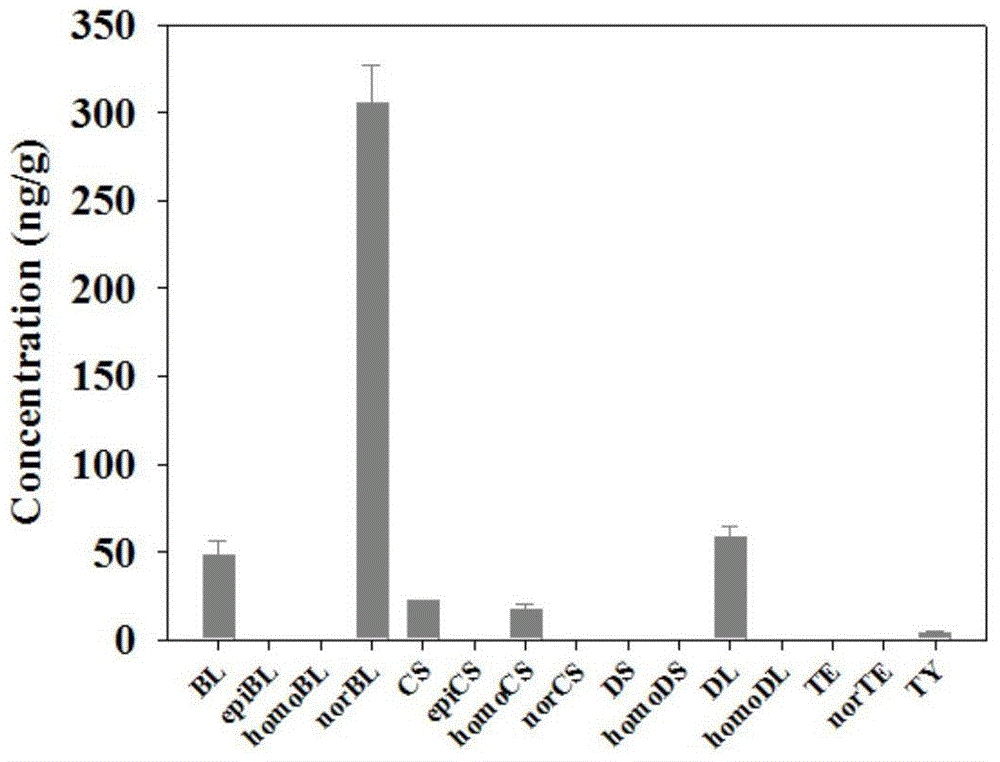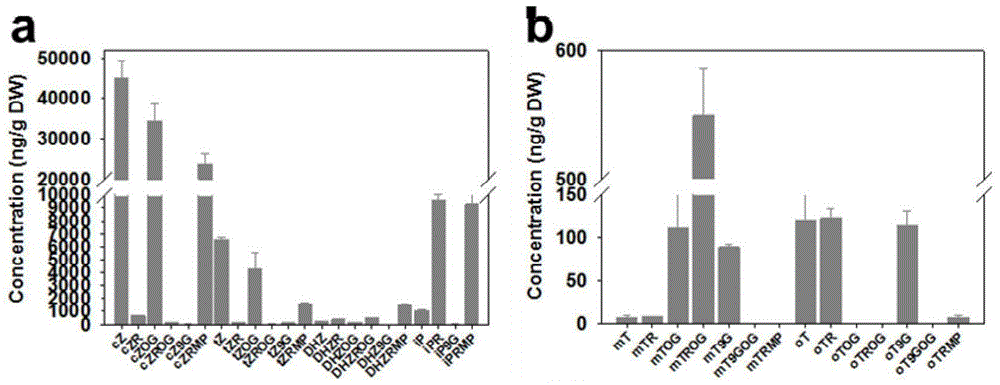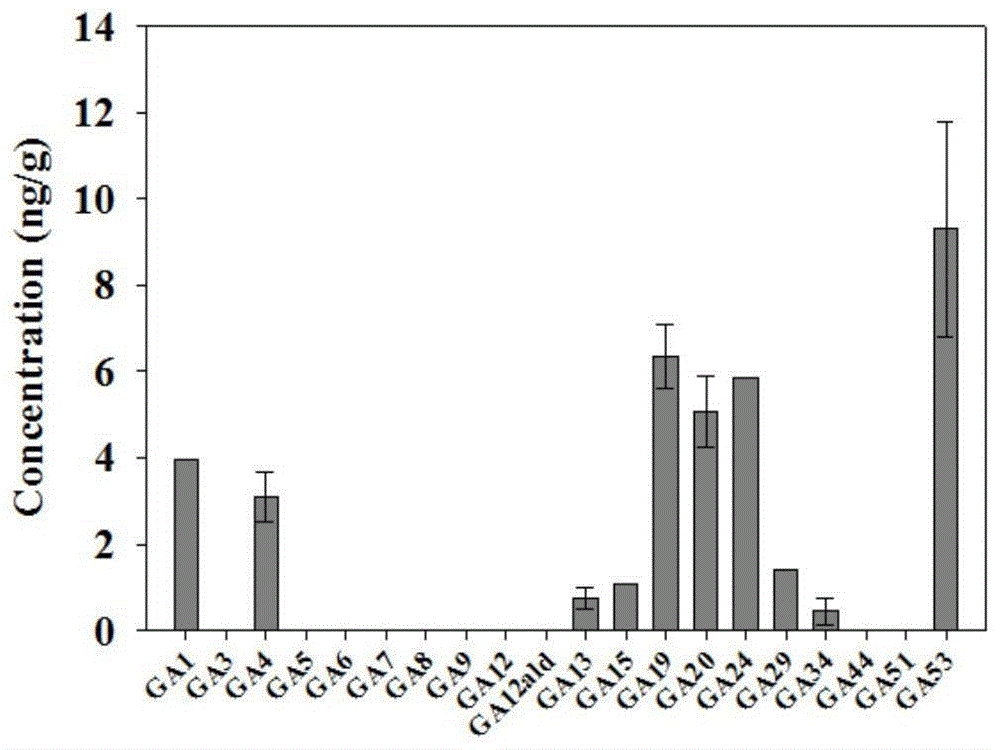Growth regulator capable of regulating growth and other functions of microalgae, and verification method and application thereof
A growth regulator and microalgae technology, which is applied in the field of biological metabolism engineering, can solve the problems of not being able to effectively increase oil accumulation, and the level of oil accumulation in algae has not been significantly improved, and achieve the effect of improving economic traits, improving physiological traits, and high-efficiency expression
- Summary
- Abstract
- Description
- Claims
- Application Information
AI Technical Summary
Problems solved by technology
Method used
Image
Examples
Embodiment 1
[0045] Example 1: Identification of algae hormones
[0046] Step 1. Algae species selection The algae species involved in the present invention include (1) green algae, such as Micromonas sp.RCC299, Ostreococcus tauri, Chlorella variabilis NC64A, Haematococcus pluvialis, Chlorella pyrenoidosa, Chlorella subellipsoidea C-169, Chlamydomonas reinhardtii, Volvox carteri, etc. (2) Red algae, such as Cyanidioschyzon merolae, Porphyridium purpureum, Gelidium amansii, Gloiopeltis furcata, Caloglossa leprieurii, Digenea simples, etc.; (3) Diatoms, such as Phaeodactylum tricornutum, Thalassiosira pseudonana, Fragilariopsis cylindrus, etc.; (4) Brown algae, such as Pelvetia canaliculata, Ecklonia hornem, Undaria pinnatifida, Ectocarpus siliculosus, etc.; (5) Pelvetia canaliculata, such as Nannochloropsis oceanica, etc., but not limited to the above algae species. The microalgae can be obtained commercially or screened from nature.
[0047] Step 2. Algae cultivation
[0048] The above-m...
Embodiment 2
[0059] Example 2: Identification of key enzymes or proteins in algae hormone metabolism and regulation
[0060]Step 1. Algae species selection The algae species involved in the present invention include (1) green algae, such as Micromonas sp.RCC299, Ostreococcus tauri, Chlorella variabilis NC64A, Haematococcus pluvialis, Chlorella pyrenoidosa, Chlorella subellipsoidea C-169, Chlamydomonas reinhardtii, Volvox carteri, etc. (2) Red algae, such as Cyanidioschyzon merolae, Porphyridium purpureum, Gelidium amansii, Gloiopeltis furcata, Caloglossa leprieurii, Digenea simples, etc.; (3) Diatoms, such as Phaeodactylum tricornutum, Thalassiosira pseudonana, Fragilariopsis cylindrus, etc.; (4) Brown algae, such as Pelvetia canaliculata, Ecklonia hornem, Undaria pinnatifida, Ectocarpus siliculosus, etc.; (5) Pelvetia canaliculata, such as Nannochloropsis oceanica, etc., but not limited to the above algae species. The microalgae can be obtained commercially or screened from nature.
[00...
Embodiment 3
[0069] Example 3: Metabolic response of microalgae hormones under nitrogen deficiency stress
[0070] Step 1. Algae species selection The algae species involved in the present invention include (1) green algae, such as Micromonas sp.RCC299, Ostreococcus tauri, Chlorella variabilis NC64A, Haematococcus pluvialis, Chlorella pyrenoidosa, Chlorella subellipsoidea C-169, Chlamydomonas reinhardtii, Volvox carteri, etc. (2) Red algae, such as Cyanidioschyzon merolae, Porphyridium purpureum, Gelidium amansii, Gloiopeltis furcata, Caloglossa leprieurii, Digenea simples, etc.; (3) Diatoms, such as Phaeodactylum tricornutum, Thalassiosira pseudonana, Fragilariopsis cylindrus, etc.; (4) Brown algae, such as Pelvetia canaliculata, Ecklonia hornem, Undaria pinnatifida, Ectocarpus siliculosus, etc.; (5) Pelvetia canaliculata, such as Nannochloropsis oceanica, etc., but not limited to the above algae species. The microalgae can be obtained commercially or screened from nature.
[0071] Step ...
PUM
 Login to View More
Login to View More Abstract
Description
Claims
Application Information
 Login to View More
Login to View More - R&D
- Intellectual Property
- Life Sciences
- Materials
- Tech Scout
- Unparalleled Data Quality
- Higher Quality Content
- 60% Fewer Hallucinations
Browse by: Latest US Patents, China's latest patents, Technical Efficacy Thesaurus, Application Domain, Technology Topic, Popular Technical Reports.
© 2025 PatSnap. All rights reserved.Legal|Privacy policy|Modern Slavery Act Transparency Statement|Sitemap|About US| Contact US: help@patsnap.com



